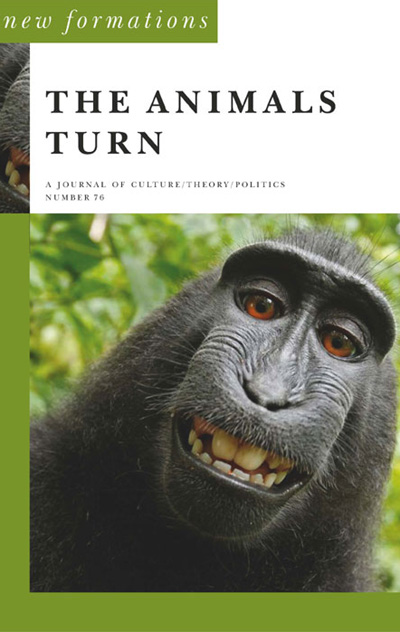
Editorial: The Animals Turn
New Formations - Print ISSN 0950-2378 - Online ISSN 1741-0789
Volume 2012 Number 76
Editorial: The Animals Turn
Wendy Wheeler, Linda Williams
Abstract
The development of a new field of study is very often just as much about a creative meaning-generation, obliging us to think in new ways (to evolve one might say), as it is simply or only about the objects of study themselves. A semiotic view of such an evolution of human knowledge would speak of this in terms of sign-objects which, in engendering new interpretants, grow the endless spiral of semiosis (i.e. knowledge) further.1 Nonetheless, the (sign) objects we choose for thinking with are telling. The direction and terrain of travel, and the sign vehicles chosen, are all clues to what kind of new knowledge we might be looking for. In the case of animal studies, and the questions addressed in this special issue of new formations, these questions seem very often to be about ethics - about our place, and the place of animals, in other words - in a long mutually shaping symbiosis of human and more-than-human relationships.2 The growing interest in animal life, both without and within us, alongside the growing understanding that all this life is semiotic, might suggest that what we are attempting to think about is life, mind and minding, and thus ethics, from a wider than human perspective.
- 1. W. Wheeler (ed and Introductory Essay), Biosemiotics: Nature/Culture/ Science/Semiosis, Living Books About Life Series (liviBL), G. Hall, J. Zylinska and C. Birchall (series eds), Open Humanities Press, 2011. http://www.livingbooksaboutlife. org/books/ Biosemiotics
- 2. P. Shepard, The Others: How Animals Made Us Human, Washington DC, Island Press/ Shearwater Books, 1996.
To cite this article
Wendy Wheeler, Linda Williams (2012) Editorial: The Animals Turn, New Formations, 2012(76)
